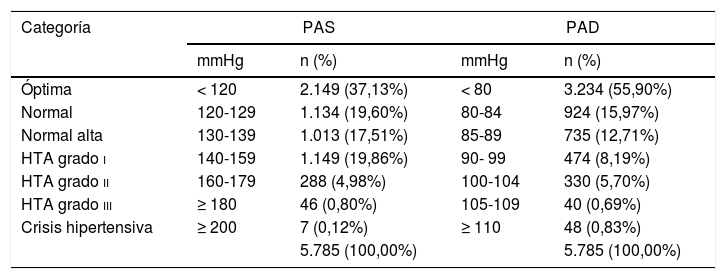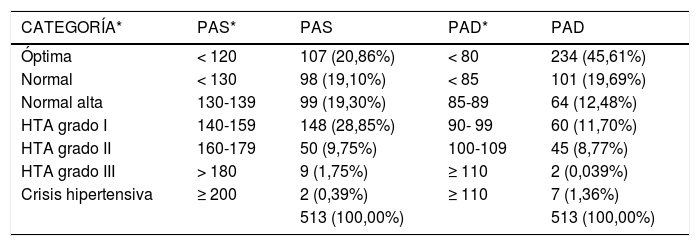Dentro del proyecto internacional May Measurement Month (MMM) en España, la farmacia comunitaria es el establecimiento sanitario en el que se llevan a cabo el mayor número de mediciones y donde se puede sensibilizar a la población sobre la importancia de la medida periódica de la presión arterial (PA).
ObjetivoConocer la situación de la PA de la población española y la difusión de la importancia de su medida periódica, a través de las farmacias comunitarias.
Material y métodosEstudio descriptivo transversal realizado en las farmacias comunitarias españolas durante el mes de mayo de 2018, entre los usuarios de las mismas, mayores de edad.
Como variables principales se midieron la presión arterial sistólica (PAS), presión arterial diastólica (PAD) y frecuencia cardíaca.
ResultadosSe llevaron a cabo 5.785 determinaciones por 891 farmacéuticos. 1.755 (34,8%) personas no se habían medido la PA en el último año. El 31,2% de los participantes tenía cifras elevadas de PA. PAS media (PASm) fue de 127,1 ± 20,1 y PAD media (PADm) de 77,5 ± 12,5, mayor en hombres (p < 0,001).
Los pacientes con valores de PA de normalidad fueron 3.981 (68,8%); elevadas una 1.226 (21,2%) y dos 578 (10%).
Los pacientes con PAS ≥ 140 fueron 912 (15,76%) y con PAD ≥ 90 fueron 314 (5,4%). Se detectaron cuatro (0,07%) emergencias hipertensivas.
ConclusionesTres de cada diez personas participantes tenían algún valor alto de PA. Por lo que, las determinaciones de PA protocolizadas realizadas en un establecimiento sanitario como la farmacia comunitaria, ha permitido identificar un número significativo de sujetos con PA elevada y no tratada.
Within the international project May Measurement Month, in Spain, the community pharmacy is where the greatest number of measurements are carried out and where the population can be made aware of the importance of regular blood pressure measurement.
ObjectivTo ascertain the situation of the Spanish population's blood pressure and dissemination of the importance of its regular measurement through the community pharmacies.
MethodsCross-sectional descriptive study carried out in Spanish community pharmacies during the month of May 2018, among pharmacy users of legal age.
Systolic blood pressure, diastolic blood pressure and heart rate were measured as main variables.
ResultsFive thousand, seven hundred and eighty-five readings were made by 891 pharmacists. One thousand, seven hundred and fifty-five (34.8%) people had not had their blood pressure measured in the last year. Of the participants, 31.2% had high blood pressure readings. Mean systolic blood pressure was 127.1±20.1 and mean diastolic blood pressure 77.5±12.5, higher in men (p<.001).
There were normal blood pressure values in 3,981 (68.8%) patients; one high reading in 1,226 (21.2%); and two in 578 (10%).
There were 912 (15.76%) patients with SBP≥140 and 314 (5.4%) with DBP≥90. Four (0.07%) hypertensive emergencies were detected.
ConclusionsThree out of ten participants had a high blood pressure reading. Therefore, protocolized blood pressure readings carried out in a health care facility such as the community pharmacy, allowed the identification of a significant number of subjects with high and untreated blood pressure.














